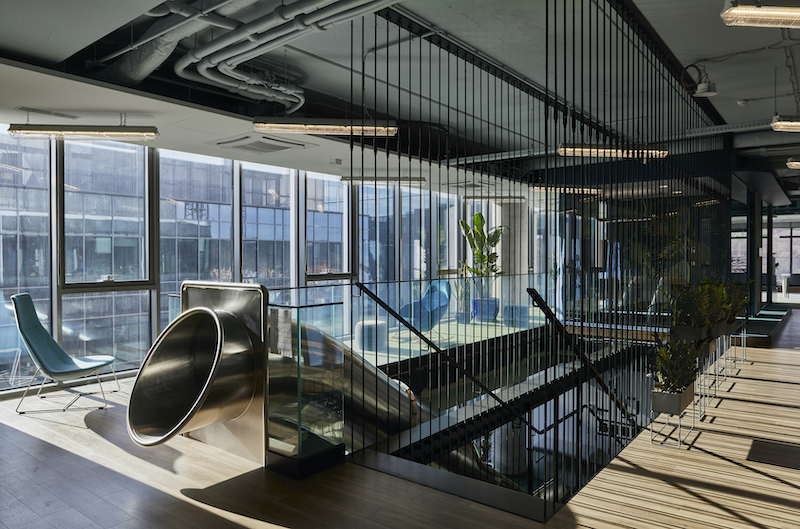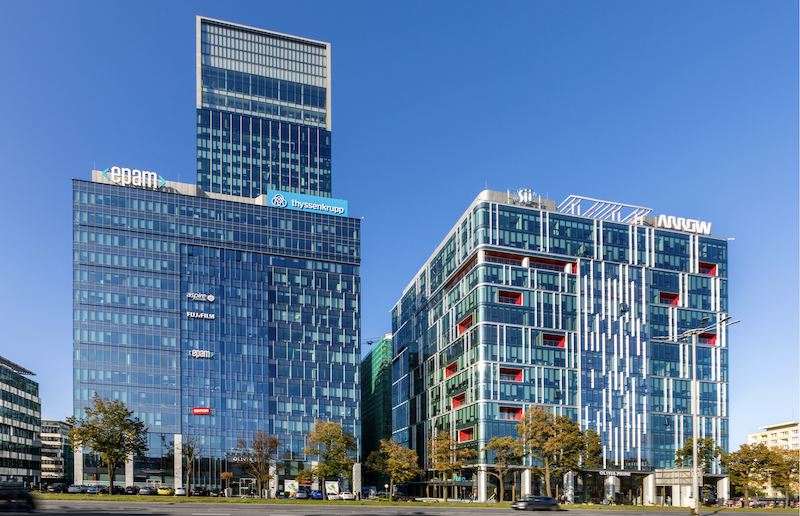The largest office complex in northern Poland is the first building to receive the highest WELL Health Safety Rating, as audited by the International WELL Building Institute (IWBI).
The Olivia Business Center, located in Gdansk, is the complex, with 230,000 sm (2.48 million sf) of office space within eight completed buildings. Olivia Building Center has been expanding since 2010. More than 8,500 people work at Olivia, whose tenants include Amazon, Bayer, PwC, and ThyssenKrupp.
The contractor for the construction of each building has been Pekabex, a leading precast concrete manufacturer. Konior and Partners developed the complex’s architectural concept, which has been continued by Gdynia-based BJK Architekci Studio. The complex’s primary investor is Maciej Grabski, cofounder of Wirtualna Polski (Virtual Poland), one of the country’s big media companies.
A LOCAL DOCTOR HELPS DEVISE SAFETY PROTOCOLS
A spokesperson for Olivia Business Center tells BD+C that the decision to make the buildings healthier stemmed from discussions, in February 2020, with Professor Krzysztof Korzeniewski, MD, Ph.D, the director of the Department of Epidemiology at a regional hospital. Korzeniewski assisted in developing procedures and planning to protect the buildings’ occupants from COVID-19.
The Olivia Business Center is one of the first complexes in the world to install ion air purification technology in its buildings. The devices saturate all internal areas with ventilated air that contains ions capable of destroying viruses, bacteria and other pathogens. The filters in the air handling units were raised to F7 from G4, and sensors for pollution and particulate matter were installed. The intensity of the air exchange in the buildings is controlled based on real-time CO2 measurements.
To maximize tenant safety, key-card sterilizers were installed, and elevator settings changed so that lift cabins stay open while in stay-by mode.
Elevators were among the common areas (including lobbies and access paths to parking lots) to which an active titanium coating was applied to ensure surfaces that are touched often are free from pathogenic organisms. The coating—developed by Lumichem and scientists at Jagiellonian University—eliminates bacteria, fungi, and viruses that come into contact with surfaces, and breaks down their residues into carbon dioxide and water.

Ventilation upgrades were among the improvements made to Olivia Business Center.
A PERFECT SCORE
To achieve its score of 25 out of 25 from IWBI (which launched its rating system last January), Olivia Business Center also made some structural changes to windows and façade in all of the buildings. Inside, occupants are directed by signage to walk in one direction to comply with social distancing guidelines. The frequency of the buildings’ cleaning regimen was increased. Cigarette sales are banned. And the building’s owner organizes free and open-to-everyone healthy activities for occupants, which include Nordic walking, cycling, or yachting excursions on the Baltic Sea.
“The safety and quality of life of our tenants are an absolute priority for us, which is why we were happy to undergo such a thorough and extensive certification process that prioritizes the comfort and well-being of our tenants,” said Konrad Danecki, head of Olivia Business Center’s utilities department, in a prepared statement.
The Center did not disclose the cost of these changes.
Related Stories
| Aug 25, 2014
Tall wood buildings: Surveying the early innovators
Timber has been largely abandoned as a structural solution in taller buildings during the last century, in favor of concrete and steel. Perkins+Will's Rebecca Holt writes about the firm's work in surveying the burgeoning tall wood buildings sector.
| Aug 25, 2014
'Vanity space' makes up large percentage of world's tallest buildings [infographic]
Large portions of some skyscrapers are useless space used to artificially enhance their height, according to the Council on Tall Buildings and Urban Habitat.
| Aug 25, 2014
Photographer creates time-lapse video of 1 WTC using 30,000 photos
Choosing from 30,000 photos he took from the day construction began in 2006 to the day when construction was finished in 2012, Brooklyn-based photographer Benjamin Rosamund compressed 1,100 photos to create the two-minute video.
| Aug 19, 2014
Goettsch Partners unveils design for mega mixed-use development in Shenzhen [slideshow]
The overall design concept is of a complex of textured buildings that would differentiate from the surrounding blue-glass buildings of Shenzhen.
| Aug 18, 2014
From icon to breadbasket: Gehry building to be turned into Whole Foods
The Howard Hughes Corporation, in association with architecture firm Cho Benn Holback + Associates, plans to turn the building—at least the majority of it—into a Whole Foods.
| Aug 18, 2014
SPARK’s newly unveiled mixed-use development references China's flowing hillscape
Architecture firm SPARK recently finished a design for a new development in Shenzhen. The 770,700 square-foot mixed-use structure's design mimics the hilly landscape of the site's locale.
| Aug 14, 2014
How workplace design can empower employees, businesses
Focusing on recent work at Follett and Zurich, CannonDesign’ Meg Osman reveals the power of research, strategy, change management, and measurement to transform businesses for the better.
| Aug 12, 2014
Shading prototype could allow new levels of environmental control for skyscraper occupants
Developed by architects at NBBJ, Sunbreak uses a unique three-hinged shade that morphs from an opaque shutter to an abstract set of vertical blinds to an awning, depending on what is needed.
| Aug 11, 2014
The Endless City: Skyscraper concept connects all floors with dual ramps
Rather than superimposing one floor on top of another, London-based SURE Architecture proposes two endless ramps, rising gradually with a low gradient from the ground floor to the sky.
| Aug 8, 2014
First look: China's latest office development will take the shape of binary code
The Window of Guangzhou project will consist of three towers forming the number sequence "001."

















